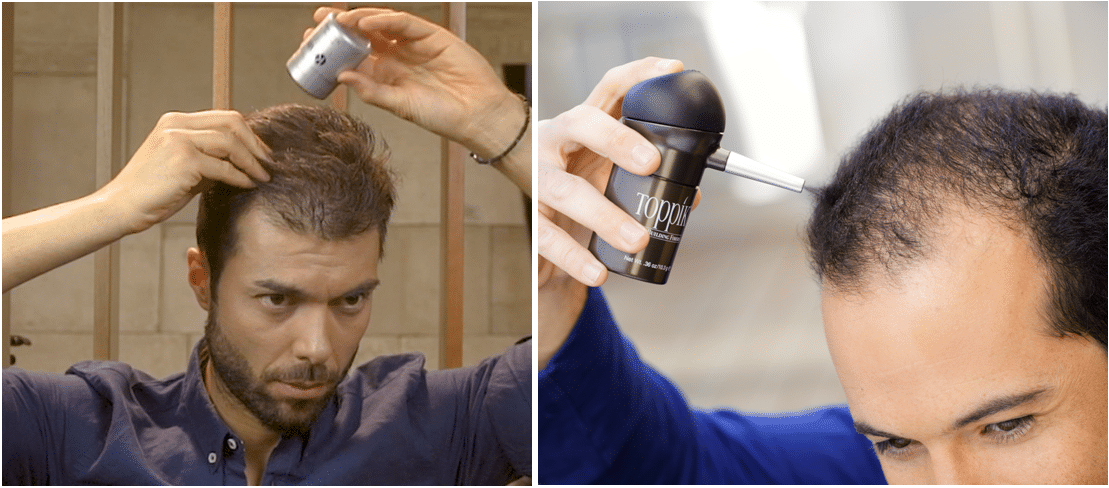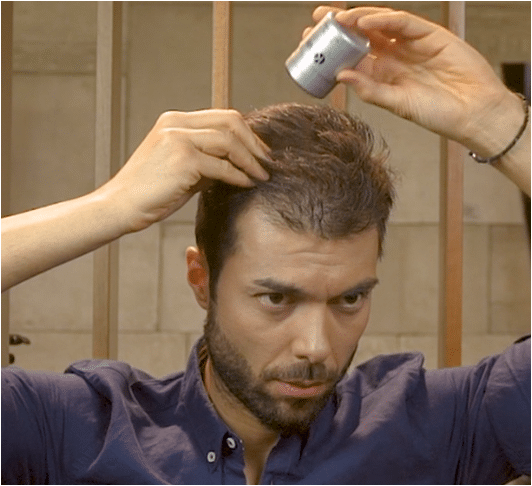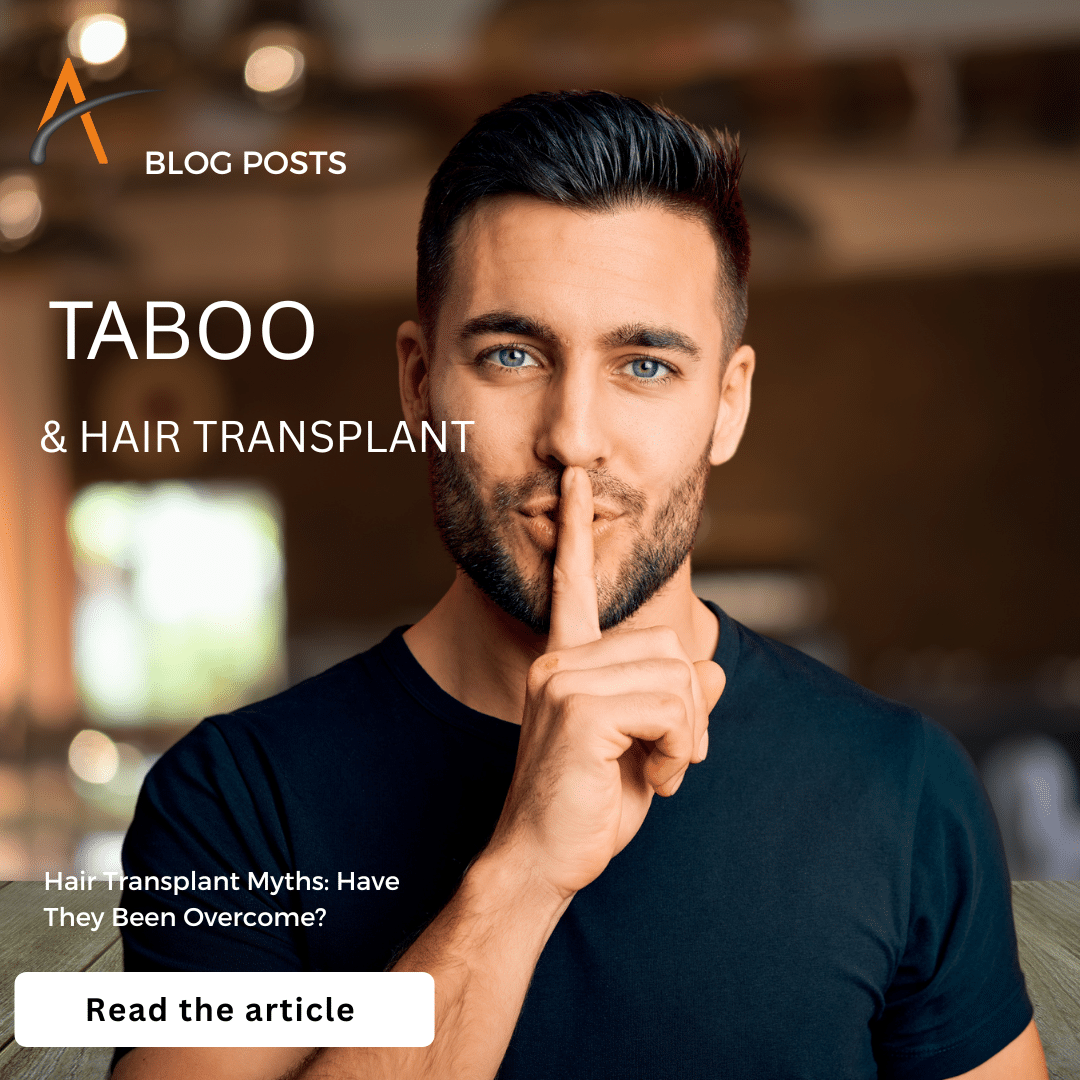What Is Hair Loss Coverage?
The term “hair loss coverage” refers to the use of cosmetic products designed to conceal or camouflage thinning hair and visible bald spots. These products offer the most immediate, accessible, and cost-effective solution, with several advantages—though they also come with certain limitations. Importantly, such products have no therapeutic effect; they do not stop or reverse hair loss.
However, when used appropriately and under the right circumstances, they can deliver impressively positive results, significantly improving both one’s appearance and psychological well-being.
In fact, many people—ranging from TV personalities and public figures to everyday individuals—use these products, often with results so natural that their use goes completely unnoticed.
The aesthetic effectiveness of these hair coverage products depends on several key factors:
- The extent and stage of hair loss (alopecia),
- The area of the scalp affected,
- The type of product used,
- And the correct method of application.
How Hair Loss Coverage Works with These Products
The effectiveness of all hair loss coverage products lies in their ability to reduce or eliminate the contrast between the scalp and the hair, creating the visual illusion of fuller hair density in areas where thinning has occurred.
However, these products can only be applied where some hair—however sparse—still exists. In completely bald areas, the change in scalp tone would be obvious and unnatural. When there are existing hairs to “anchor” the product and blend with the scalp, the results are often very good to truly impressive.
Indications for Use
Hair coverage products are suitable for a wide range of individuals, including:
- Men with androgenetic alopecia (male pattern hair loss)
- Women with female pattern hair loss
- Individuals of any gender with diffuse thinning or generalized hair loss, regardless of cause
- Those with scarring alopecias or localized hair loss patches (e.g., alopecia areata)
- Patients who have undergone outdated hair transplant techniques resulting in unnatural appearance
- Individuals who recently had a hair transplant, to conceal post-operative signs in the recipient area or temporary shedding (telogen effluvium)
- Patients with a successful hair transplant who simply want to enhance overall density
These products are best suited for individuals with mild to moderate hair loss—typically Norwood-Hamilton stages II to V. Those in advanced stages (VI–VII) are generally not good candidates, as they lack sufficient hair for the product to adhere to.
A particularly important consideration: Hair transplant patients can safely use these products, provided they have the approval of their treating physician. Application is recommended:
- During the healing phase to mask signs in the recipient area
- In the long term, to further enhance the aesthetic outcome—especially since the previously bald areas now contain transplanted hairs, allowing the products to perform effectively.
Categories of Hair Loss Concealment Products
Hair loss concealment products generally fall into four main categories:
- Keratin Microfibers
These products contain tiny keratin fibers that cling to existing hair strands through static electricity, instantly creating the appearance of fuller, thicker hair and enhancing coverage. - Solid Compacts (Hair Powders)
These are compressed powders applied with a specialized applicator directly to the scalp and hair, effectively coloring both and camouflaging areas of thinning. - Color Sprays
Similar to a conventional hair spray, but tinted, these products are sprayed onto the scalp and hair, providing instant color and visual density. - Tinted Lotions or Creams
Available in liquid or creamy form, these act similarly to solid powders by tinting the scalp, helping to reduce contrast between hair and skin.
Color Matching & Custom Use
Each type of concealer is available in a variety of colors, designed to match both natural and dyed hair tones. In many cases, users may combine two different products (e.g., keratin fibers and hair powder) to further reduce contrast and create a more natural appearance.
Key Factors for Natural-Looking Results
For a successful outcome, two conditions must be met:
- Proper Product Selection & Application
The primary goal is always a natural appearance. The right product used correctly will blend seamlessly with the hair and scalp, delivering excellent aesthetic results without being noticeable. - Discreet Use
Concealer products should not be detectable by others. This means avoiding excessive application in an effort to fully cover hair loss.
Patients should understand that “slightly thinning” looks far more natural than “obviously artificial.” Even the most advanced product will appear fake if overused.
Ultimately, hair loss concealers are a quick, accessible, and cost-effective solution that, when applied correctly, can significantly improve both appearance and confidence.
- Proper Product Selection & Application
Hair Concealers – Fiber-Based Hair Building Products and Their Use
Hair concealer products can be used safely and effectively in combination with topical Minoxidil solutions (MTS) or Minoxidil Topical Foam (MTF), as well as after hair transplantation procedures.
Guidelines for Use with Minoxidil (MTS/MTF)
For individuals using Minoxidil:
- Apply the MTS/MTF first to a clean, dry scalp.
- Allow the solution or foam to dry completely before applying any hair concealer products.
- Before the next application of Minoxidil, it is essential to thoroughly remove any hair concealer residue from the scalp to ensure maximum absorption.
Recommended Daily Routine
- Morning: On clean, dry hair, apply Minoxidil Topical Solution (MTS) or Minoxidil Topical Foam (MTF).
Once completely dry, apply the desired hair concealer, ideally keratin-based hair fibers, to the thinning areas. - Evening: Before bed, wash the scalp thoroughly to remove any concealer residue.
Then apply MTS or MTF to a clean scalp. - Following Morning: Repeat the above steps daily.
Hair Building Fibers – Effectiveness and Quality
Hair fibers are among the most effective and natural-looking solutions for concealing thinning hair—when used correctly. The source and quality of the fibers play a crucial role in the final aesthetic result as well as in user safety.
There are three main types of hair-building fiber origins:
- 100% Natural Keratin Fibers
- Derived from pure keratin (the same protein found in natural hair).
- Offer superior quality, safety, and a highly realistic appearance.
- Considered the gold standard in fiber-based concealers.
- Derived from pure keratin (the same protein found in natural hair).
- Plant-Based Fibers
- Sourced from plants such as cotton.
- While generally safe, they may lack the natural texture and adherence properties of keratin fibers.
- Sourced from plants such as cotton.
- Low-Quality or Synthetic Fibers
- Made from nylon, fish bones, nail-derived keratin, or other industrial by-products.
- These are lower-quality alternatives that may cause scalp irritation, allergic reactions, or other dermatological issues.
- Made from nylon, fish bones, nail-derived keratin, or other industrial by-products.
Conclusion
For the best and safest results, it is highly recommended to choose high-quality hair fibers made from 100% natural keratin, especially for those who are also using Minoxidil or have undergone hair restoration procedures. When used properly, these fibers offer instant, natural coverage and significantly improve both appearance and confidence.

Fig. 1: Cases of men and women before and after the use of natural keratin microfibers.
Keratin Hair Fibers – Advanced Nanotechnology for Hair Coverage
Hair fiber products are a result of cutting-edge nanotechnology, with keratin microfibers having only emerged in recent years. Unlike traditional hair concealers that rely on directly coloring the scalp to reduce the contrast between skin and hair, keratin fibers offer a more advanced approach.
Made from natural keratin—the same protein that forms the primary structural component of human hair—these microfibers adhere to thinning hairs through natural static electricity. Once applied, they blend seamlessly with existing hair, creating the illusion of fuller, thicker hair in a way that looks completely natural.

How Keratin Hair Fibers Work & How to Use Them
Natural keratin hair fibers are stored in a cylindrical container with small holes at the top. Application is simple and similar to using talcum powder—by gently shaking the container up and down, the fibers fall directly onto existing hair, where they bind instantly through natural static electricity.
For greater precision and a more natural finish, especially in areas with lighter thinning or around the hairline, a specially designed fiber applicator tool can be used (Fig. 2). This tool allows for targeted application, delivering the fibers exactly where needed.
To visualize the effect, imagine a tree in winter—bare branches (before)—and the same tree in spring, now full of leaves (after). In this analogy, the keratin fibers act like leaves, attaching almost vertically to your existing hairs, instantly making them appear thicker, fuller, and denser (Fig. 3 & 4).
For added hold and durability, a specially formulated fiber-hold spray can be used after application. This ensures long-lasting results, even in conditions involving wind, rain, or physical activity.
Finally, the patented fiber applicator enhances precision further by dispersing the fibers horizontally. This ensures ultra-natural coverage, even in highly demanding areas like the frontal hairline.

Fig. 3: The branches represent the thinning hairs and the leaves represent the microfibers. Just as the sky is not visible through the leaves, likewise the scalp skin is not visible through the microfibers.

Fig. 4: Representation of microfiber adhesion to the hair and depiction of the result on thinning hair.
Do Keratin Fibers Work on All Types of Hair Loss?
Keratin microfibers adhere securely even to the finest vellus hairs on the scalp, thanks to their natural static charge, which acts like a magnetic force. However, completely bald areas with no existing hair cannot hold the fibers effectively, as there’s no structure for the fibers to cling to. As a result, men with advanced androgenetic alopecia and women with extensive diffuse thinning are not ideal candidates for using keratin fiber products (Fig. 5). That said, even in areas with minimal hair, if applied correctly, the results can be exceptional. Regardless of the stage of hair loss or the lighting conditions, the coverage achieved with high-quality hair fibers remains undetectable to the naked eye, even at very close range (Fig. 6).

Fig. 5: Stages of AGA and FPHL in which the use of microfibers is ideal.
Hair Building Fibers: Resistance & Versatility
Hair thickening fibers made from natural keratin are resistant to wind, rain, and sweat. The only way to remove them from the hair is through shampooing—and even a single wash with regular shampoo is enough. On other surfaces, such as clothing, pillowcases, or bedding, the fibers can be easily removed with a simple shake or blow, since they do not adhere in the absence of static electricity. They also do not stain the hands, even if the hair is touched.
What sets keratin fiber products apart from other hair concealers is their unique mechanism of action, which allows them to be used effectively on all hair types—straight, curly, wavy, fine, weak, colored, or gray.
Most importantly, they are the only type of concealer suitable for application on the hairline—the most visually critical area of the scalp for achieving a natural-looking result.

Fig. 6: Size of Toppik microfibers on graph paper with 1 mm squares.
Shades and Safety of Natural Keratin Hair Fibers
Most hair fiber products for hair loss concealment are available in nine shades: black, dark brown, medium brown, light brown, auburn, dark blonde, light blonde, gray, and white.
Natural keratin fibers are not a medication. They contain no chemicals, are inert and safe for use. These fibers are registered with the European Cosmetics Notification Portal (CPNP) and can be used safely alongside any pharmaceutical treatment for hair loss.
Regarding their pigments, these usually belong to the FDC category (Food, Drugs, Cosmetics), meaning the colors are approved for use in food products, pharmaceuticals, and cosmetics. However, some natural keratin hair fibers do not contain any artificial dyes at all. Their color is achieved simply by mixing naturally colored fibers in varying proportions to create the desired natural shades.
Natural Keratin Hair Fibers and Hair Transplantation
A hair loss concealing product containing natural keratin fibers is recommended and can be safely used both before and after a hair transplant, because:
- It combines well with any hair loss treatment without causing interactions.
- It helps the user maintain a positive image of their hair, preventing discouragement and encouraging continuation of the hair growth treatment prescribed by their physician.
- It provides psychological support, increasing the likelihood of success with the hair growth therapy.
- It enhances the natural appearance of the hair transplant results.
- It significantly improves the perceived density and coverage of the transplanted area.
- It conceals postoperative scars during the early healing days.
- It masks temporary postoperative hair thinning (Telogen Effluvium).
It offers important psychological support until the transplant results become visibly noticeable.
Natural Keratin Hair Fibers
Advantages:
- They are the most effective and globally popular product for concealing hair thinning.
- Suitable for both men and women experiencing hair loss or thinning hair.
- Completely undetectable; only the user knows they are using it.
- Very economical.
- Quick application—1 to 2 minutes is enough for full coverage.
- 100% natural product made from keratin microfibers.
- Inert product, free from chemicals, excipients, and synthetic substances.
- Not a drug; does not affect hair, scalp, or hair follicles.
- Not a spray, dye, or cream—does not stain the skin or hair.
- Does not irritate the skin or cause allergic reactions.
- Can be used immediately after hair transplantation, as it does not stain the skin and can cover temporary wounds without interfering with healing.
- Available in a wide range of sizes, including travel packs.
- Does not alter the natural texture or appearance of the hair, as it neither dyes nor leaves a powdery residue.
- Discreet coverage that blends seamlessly with natural hair.
- Resistant to wind, rain, sweat, and physical activity.
- Does not come off from touching, combing, or wearing helmets.
- Compatible with any topical treatment for androgenetic alopecia.
- Easily washable—just one shampoo wash is sufficient since it contains no synthetic substances.
Disadvantages:
- May require the use of a spray/holding product for better fixation, which entails a minor additional cost.
- Not waterproof; while it resists rain satisfactorily, it will not hold during swimming.
- Application at the hairline requires the use of the Spray Maximizer® tool, which ensures precise application and significant product savings.
- Not suitable for individuals with fully bald areas (Norwood-Hamilton stages VI-VII).
Solid Powders
Solid powders are provided in the form of circular powder disks, similar to compact powder used in cosmetics. They are applied to the scalp and dry hair using a damp sponge applicator (Fig. 7). These products color both the scalp and the fine vellus hairs by creating a layer of tinted powder that reduces the color contrast between the hair and scalp skin. Additionally, the hairs appear somewhat thicker, while the scalp takes on a matte, overly dry appearance. After application, the hair is brushed for a more even distribution of the product. Once the hair dries, hairspray or gel can be used; however, during gel application, the hands may become stained. Once the powder dries, though, touching the hair does not transfer color to the hands.

Fig. 7: Typical solid powder product that provides satisfactory coverage, is almost waterproof, but makes the hair look ‘matte’ and dry, is very difficult to wash out, and is associated with irritation.
Solid Powders – Limitations and Considerations
Depending on the stage of androgenetic alopecia and the lighting conditions, the coloration of the scalp with solid powders can sometimes be noticeable at close range. In areas requiring precision, such as the hairline, a reasonably satisfactory application can be achieved, but not the excellent result attainable only with hair fiber products.
Solid powders are generally water-resistant, allowing the user to be briefly exposed to water without significant loss of coverage. However, the product is removed through washing, which typically requires 3–4 thorough shampoo washes with strong detergents to fully eliminate the powder. This process can be harsh on both the scalp and hair due to the need for potent cleansing agents.
The occurrence of irritant and allergic dermatitis from contact with solid powders is relatively common. Potential allergens and irritants present in these powders include ethylenediamine, propylene glycol, methyldibromo glutaronitrile, phenoxyethanol, methylparaben, and fragrances. Additionally, solid powders contain waxes and oily substances that may increase sebaceous gland secretion and potentially exacerbate androgenetic alopecia.
Finally, solid powders must not be used on the recipient area following hair transplantation for at least 14 days post-surgery. This restriction is due to their ingredients and the fact that removing the product requires vigorous rubbing of the area, which is prohibited during this healing period
Spray Products for Hair Loss Concealment
These products for concealing hair loss are similar to regular hair sprays, with the difference that the aerosol they emit is colored. They temporarily dye both the scalp and the hair strands, providing immediate coverage. Their main advantage is the speed and ease of application. These sprays are used on dry hair and can also add a moderate amount of volume (texture) to the hair.

Fig. 8: Spray products are easily noticeable, stain clothes, fade, and do not withstand rain or sweat.
Colored Spray Products for Hair Loss Concealment
Depending on the stage of androgenetic alopecia and the lighting conditions in the room, the scalp coloration achieved with colored sprays can often be easily noticeable. Only a few cases of androgenetic alopecia can use these products and achieve a natural result. In areas requiring precision, such as the hairline, accurate application is impossible. (Fig. 8)
Colored spray products for hair loss concealment are not water-resistant, and users should avoid exposure to water or rain, as the product may run down the forehead like paint, causing visible staining. Additionally, their use significantly soils the application area, clothing, and any nearby surfaces. Anyone who has used common spray paint knows how far the overspray can spread. Even after drying, colored spray on the hair continues to stain the hands upon contact.
Removal requires washing, often needing at least three thorough shampoos with strong detergents to completely eliminate the product. This can be harsh on both the scalp and hair due to the intensive cleansing agents required. Irritative and allergic dermatitis reactions are fairly common with colored sprays, especially due to propellants such as Dimethyl Ether and Hydrofluorocarbon 152A, as well as SD Alcohol-40 and Propylene Glycol, which can dry out hair and scalp. Potential allergens/irritants in these colored sprays include Dimethyl Ether, Hydrofluorocarbon 152A, SD Alcohol-40, Propylene Glycol, and PVP/PA Copolymer.
Finally, colored spray products should not be used on the recipient area following hair transplantation for at least 14 days after the procedure. This restriction is due both to their ingredients and the fact that removing the product requires vigorous rubbing of the area, which is contraindicated during this period.
Tube Products for Hair Loss Concealment
These products appeared in the late 1970s and were the first designed specifically for hair loss coverage. They come in a tube similar to toothpaste and contain a colored paste. The paste is applied to the scalp using a sponge, intensely coloring the skin and lightly tinting the fine vellus hairs (Fig. 9). This reduces the color contrast between hair and scalp. It also makes the hairs appear thicker, while the scalp looks overly shiny, unlike powders which give an excessively matte appearance. After application, hair should not be brushed. Once dry, hairs can be styled with hairspray or a small amount of gel, but hands get stained during the process. Even after drying, the paste continues to stain the hands when touching the hair.

Fig. 9: A colored paste product that provides decent coverage but stains the hands and does not wash off easily with shampooing.
Depending on the stage of androgenetic alopecia and the lighting conditions, coloring the scalp with tinted pastes can easily become noticeable from a close distance. Only a few cases of androgenetic alopecia can use these products and achieve natural results. In areas requiring detailed coverage, such as the hairline, it is impossible to achieve precise application and a natural appearance. Tinted pastes are not water-resistant, and users must avoid water or rain because the product can run like paint onto the forehead, causing embarrassment.
The product is removed by washing, but at least 3–4 washes with strong shampoo are required for complete removal. This can be harsh on the scalp and hair, as strong detergents are needed. The occurrence of irritant and allergic dermatitis from contact with tinted pastes is quite common. Potential allergens/irritants contained in tinted pastes include Propylene Glycol, Isopropyl Myristate, Sesame Oil, Glycerides, Triethanolamine, Propylparaben, Methylparaben, Imidazolidinyl Urea, Disodium Oleamido PEG-2 Sulfosuccinate, and fragrances. They also contain waxes and oily substances that increase sebum secretion and may worsen androgenetic alopecia.
Finally, tinted pastes are not permitted for use on the recipient area following hair transplantation. This restriction lasts at least 14 days after the procedure, both due to their ingredients and because their removal requires vigorous rubbing of the area, which is prohibited during this period.
SUMMARY
Products for hair thinning coverage can significantly improve the appearance of individuals with androgenetic alopecia. Ideal candidates are those with hair thinning. Hair thickening fibers provide a completely natural result with minimal application time—just a few seconds are enough, and the effect lasts all day, as long as the hair isn’t touched frequently.
All users report impressive improvement in their appearance and psychological well-being. The product is also ideal for use after hair transplantation, as it covers temporary scars and thinning, while the combination of 100% natural keratin fibers with a proper hair transplant can truly transform appearance, even in advanced stages of alopecia (Hamilton-Norwood stage VII).











